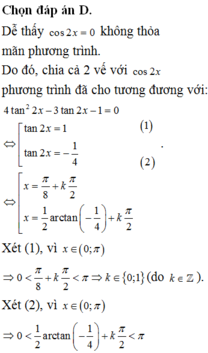


Hãy nhập câu hỏi của bạn vào đây, nếu là tài khoản VIP, bạn sẽ được ưu tiên trả lời.




Chọn C
Ta có: ![]() nên (1) và (2) có nghiệm.
nên (1) và (2) có nghiệm.
Cách 1:
Xét: ![]()
![]() nên (3) vô nghiệm.
nên (3) vô nghiệm.
Cách 2:
Điều kiện có nghiệm của phương trình: sin x + cos x = 2 là: 
(vô lý) nên (3) vô nghiệm.
Cách 3:
Vì 

nên (3) vô nghiệm.

Tính \(I=\int_0^{\dfrac{\pi}{2}}\dfrac{cos^{2017}x}{sin^{2017}x+cos^{2017}}dx\left(1\right)\)
Đặt \(t=cosx\Rightarrow sinx=\sqrt{1-cos^2x}\)
\(\Rightarrow dt=-sinx.dx\)
\(\Rightarrow I=\int_0^1\dfrac{t^{2017}.}{\sqrt{1-t^2}.\left(\left(\sqrt{1-t^2}\right)^{2017}+t^{2017}\right)}dt\)
Đặt: \(t=siny\Rightarrow\sqrt{1-t^2}=cosy\)
\(\Rightarrow dt=cosy.dy\)
\(\Rightarrow I=\int_0^{\dfrac{\pi}{2}}\dfrac{sin^{2017}y.cosy}{cosy\left(cos^{2017}y+sin^{2017}y\right)}dy=\int_0^{\dfrac{\pi}{2}}\dfrac{sin^{2017}y}{\left(cos^{2017}y+sin^{2017}y\right)}\)
\(\Rightarrow I=\int_0^{\dfrac{\pi}{2}}\dfrac{sin^{2017}x}{\left(cos^{2017}x+sin^{2017}x\right)}\left(2\right)\)
Cộng (1) và (2) ta được
\(2I=\int_0^{\dfrac{\pi}{2}}\dfrac{sin^{2017}x+cos^{2017}x}{sin^{2017}x+cos^{2017}x}dx=\int_0^{\dfrac{\pi}{2}}1dx\)
\(=x|^{\dfrac{\pi}{2}}_0=\dfrac{\pi}{2}\)
\(\Rightarrow I=\dfrac{\pi}{4}\)
Thế lại bài toán ta được
\(\dfrac{\pi}{4}+t^2-6t+9-\dfrac{\pi}{4}=0\)
\(\Leftrightarrow t^2-6t+9=0\)
\(\Leftrightarrow t=3\)
Chọn đáp án C
mỗi trắc nghiệm thoy mà lm dài ntn s @@
chắc lên đó khó lắm ag

a.
\(y'=\dfrac{2-x}{2x^2\sqrt{x-1}}=0\Rightarrow x=2\)
\(y\left(1\right)=0\) ; \(y\left(2\right)=\dfrac{1}{2}\) ; \(y\left(5\right)=\dfrac{2}{5}\)
\(\Rightarrow y_{min}=y\left(1\right)=0\)
\(y_{max}=y\left(2\right)=\dfrac{1}{2}\)
b.
\(y'=\dfrac{1-3x}{\sqrt{\left(x^2+1\right)^3}}< 0\) ; \(\forall x\in\left[1;3\right]\Rightarrow\) hàm nghịch biến trên [1;3]
\(\Rightarrow y_{max}=y\left(1\right)=\dfrac{4}{\sqrt{2}}=2\sqrt{2}\)
\(y_{min}=y\left(3\right)=\dfrac{6}{\sqrt{10}}=\dfrac{3\sqrt{10}}{5}\)
c.
\(y=1-cos^2x-cosx+1=-cos^2x-cosx+2\)
Đặt \(cosx=t\Rightarrow t\in\left[-1;1\right]\)
\(y=f\left(t\right)=-t^2-t+2\)
\(f'\left(t\right)=-2t-1=0\Rightarrow t=-\dfrac{1}{2}\)
\(f\left(-1\right)=2\) ; \(f\left(1\right)=0\) ; \(f\left(-\dfrac{1}{2}\right)=\dfrac{9}{4}\)
\(\Rightarrow y_{min}=0\) ; \(y_{max}=\dfrac{9}{4}\)
d.
Đặt \(sinx=t\Rightarrow t\in\left[-1;1\right]\)
\(y=f\left(t\right)=t^3-3t^2+2\Rightarrow f'\left(t\right)=3t^2-6t=0\Rightarrow\left[{}\begin{matrix}t=0\\t=2\notin\left[-1;1\right]\end{matrix}\right.\)
\(f\left(-1\right)=-2\) ; \(f\left(1\right)=0\) ; \(f\left(0\right)=2\)
\(\Rightarrow y_{min}=-2\) ; \(y_{max}=2\)